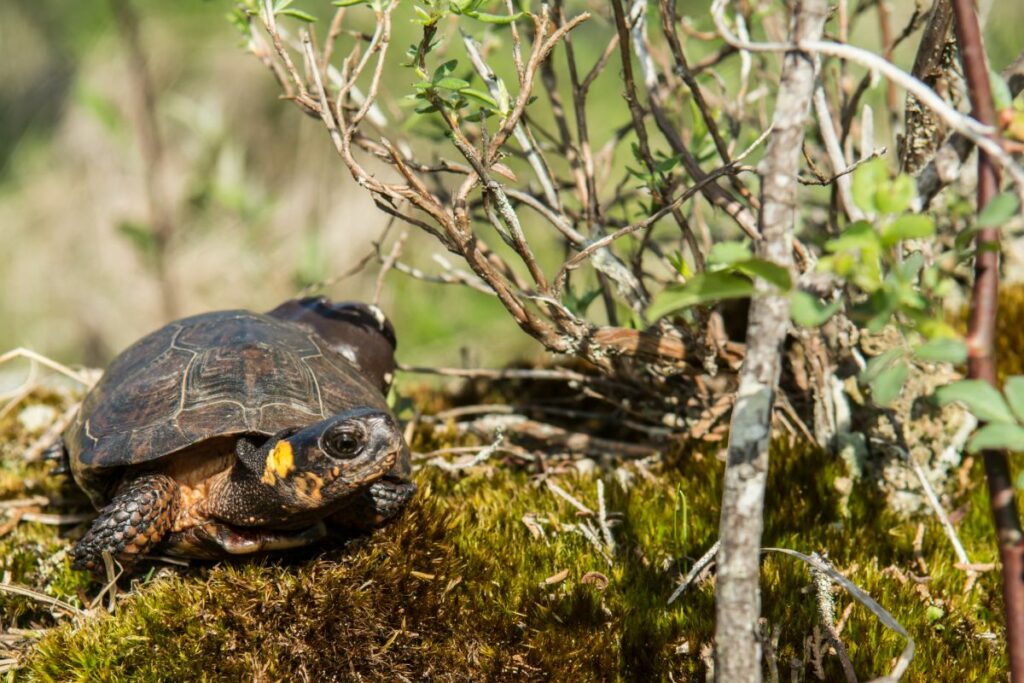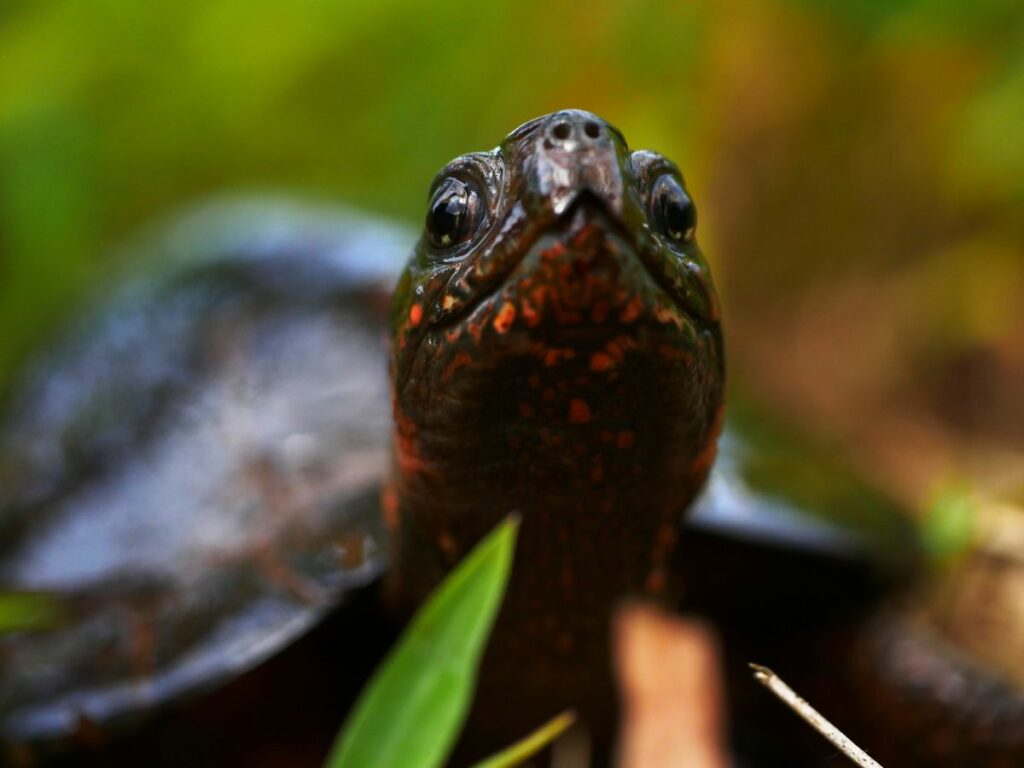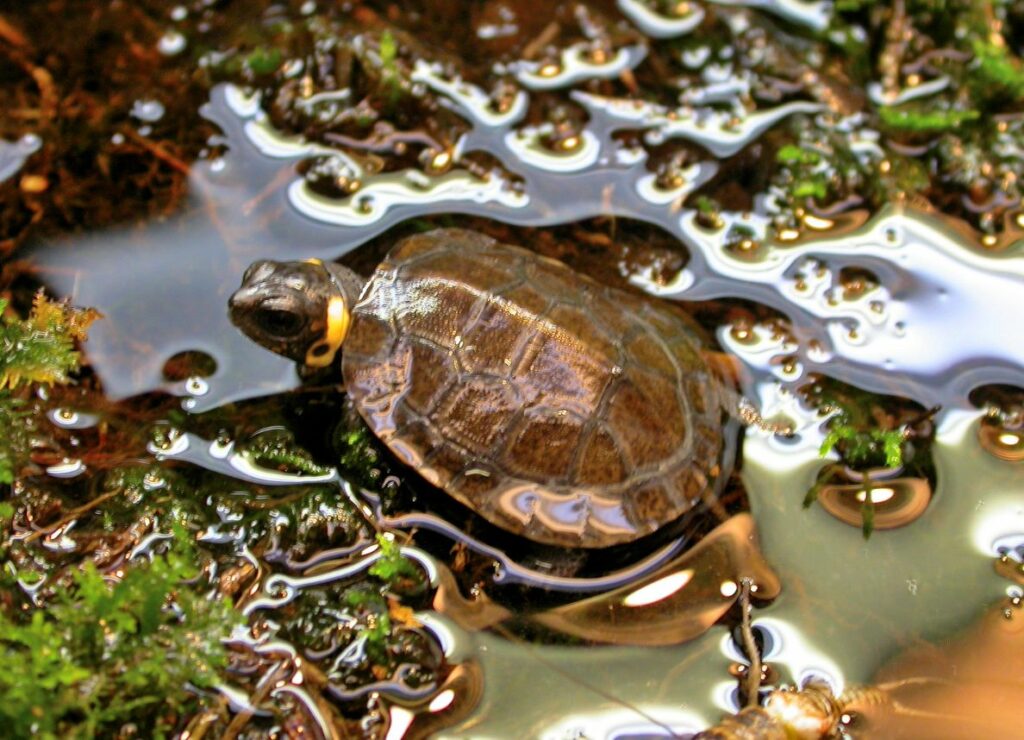A bog turtle is the smallest species of turtle in the United States, and they live in few areas throughout the country. Their populations are fragmented and dwindling, so it’s unlikely you’ll ever see these turtles in the wild.

They love cool, wet, and acidic bog habitats where they can hide amongst the mud and vegetation.
What Is A Bog Turtle?
A bog turtle is the smallest turtle you can own in the United States, and is also the smallest species of turtle in the country. A full-grown bog turtle may only reach a maximum length of 4.5 in (11.4 cm).
Despite their small size, they’re easily noticeable and recognizable because of a bright orange patch on either side of their face.
Their upper shell (carapace) is light to dark brown, but the scutes are lighter at the center with lines that radiate outwards. The bottom shell (plastron) is a darker brown with black patches. The shell has no hinge.
You can tell males from females because their tails are longer and thicker. Their plastrons are also slightly concave to accommodate mating.
- Common Names: Bog Turtle, American Bog Turtle
- Scientific Name: Glyptemys muhlenbergii
- Origin: Eastern United States
- Bog Turtle Size (Length): Up to 4.5 in (11.4 cm)
- Lifespan: Up to 60 years
- Enclosure Size: 2×3 ft (0.6-0.9 m)
- Temperament: Semi-aggressive
- Ease of Care: Easy
Bog Turtle Habitat
Bog turtles are native only to the eastern United States. There are two separate populations, each about 250 miles (402.3 k) from the other. Referring to two populations makes research and monitoring easier. Yet, the populations are actually fragmented with turtles forming small colonies throughout either range.
The northern population spreads across eastern Pennsylvania, southern New York, New Jersey, and Massachusetts. The northern population is much larger than the one in the south.
The southern population extends across the Southern Blue Ridge of North and South Carolina and Georgia. Unfortunately, the southern population is now so sparse that it is in danger of disappearing.
As their name suggests, bog turtles live in mountain bogs, and open, wet meadows fed by groundwater. Various grasses and tussock sedge often surround their favorite habitats. The bogs and wetlands in which they live comprise soggy and acidic soil dominated by layers of thick mud.
Such habitats are great for bog turtles because they offer excellent protection. The thick, wet soil is hard for most predators to traverse. The soil also offers protection from adverse weather.
Despite their soggy consistency, bogs receive lots of sunlight which bog turtles need to bask and lay eggs.
Behavior & Temperament

These tiny turtles are most active during the day. They prefer cooler temperatures and move little in the heat. The University of Michigan Museum of Zoology describes this activity:
“On cool days Bog Turtles spend much time basking in the sun, from the surface of shallow waterways or on sedge or grass tussocks, but during hot weather they tend to be inactive and may estivate under vegetation or in burrows in sphagnum moss substrate.”
They hibernate over the winter, burrowing themselves in mud and vegetation. Often, turtles will use the same hibernation sites year after year. Multiple turtles may congregate for hibernation.
Bog turtles may also be territorial, fiercely defending a small area of habitat from other turtles.
What Do Bog Turtles Eat?
Bog turtles are omnivorous, and they enjoy eating worms, beetles, snails, aquatic vegetation, and berries.
Reproduction
Bog turtles reach sexual maturity around 6-7 years of age.
Breeding occurs between March and May. To entice a female, a male nudges and bites her head, legs, and shell. Once he has mounted her, he often thumps her carapace with his plastron.
Females create their nests in sunny and elevated areas of sphagnum moss or sedge. They lay between one to six eggs, only laying a single clutch a year. Incubation lasts for about 45-65 days and the eggs hatch between August and October.
How To Care For A Bog Turtle
You must be careful where you buy a bog turtle if you decide to keep one as a pet. Bog turtles are a critically endangered species and are incredibly rare. It is illegal to collect wild bog turtles to sell, but many people still do it.
Do thorough research on any breeder you come across before considering buying a bog turtle from them.
Enclosure
A single bog turtle needs an enclosure at least 2×3 ft (0.6-0.9 m), but the enclosure needs to be at least twice that size if you want two turtles.
Your turtle needs shallow water they can swim in, but they need terrestrial space with plenty of hiding spaces.
The water space should have areas of varying depths, but the depth should never exceed the length of the turtle’s shell.
Substrate
Leaf litter or fine mulch is the best substrate, as it mimics the soft substrate of bogs.
Decorations
Provide lots of hiding spaces such as terracotta pots, logs, and fake or live plants. Ensure that any hiding spots are large enough for them to turn around to avoid them getting stuck.
Temperature & Lighting
Bog turtles are more active when the weather is cooler, but they still need a hot basking spot and heating lamps.
Place a UVB bulb next to a heat lamp to create a basking spot. A UVB bulb is essential in maintaining the health of your turtle’s bones and shell.
Keep the basking temperature between 85-95°F (29.4-35°C), the ambient temperature between 75-85°F (23.9-29.4°C), and the water temperature between 65-75°F (18.3-23.9°C).
Tank Mates
With a large enough tank, you can keep multiple bog turtles. Only keep a single male to avoid fighting.
Diet
Adult bog turtles only need feeding 3-4 times a week, but juvenile turtles should receive feeding every day. About ⅔ of their diet should comprise protein, and ⅓ of vegetables. Be sure to sprinkle their food with a calcium supplement for the health of their shell and bones.
Why Is The Bog Turtle Endangered?
Bog turtles were assessed in 2010 by The International Union for the Conservation of Nature (IUCN) They listed the turtle as “critically endangered” with an unknown population trend.
Bog turtles are losing their habitats to housing, urban, commercial, and industrial development.
Their habitat is also being destroyed for agriculture, livestock farming, and ranching.
Bog turtle populations are delicate, and any change in the climate or environment may lead to them becoming extinct. The Endangered Species Coalition describes the predicament:
“Current bog turtle population is unknown, but estimates range from 2,500 to 10,000. Invasive plants such as the purple loosestrife can dry out large areas of suitable habitat. Purple loosestrife grows in large, compact clumps that are impenetrable to the turtle, restricting its movement.
Bog turtles are extremely sensitive to the effects of global warming. The turtle’s survival is closely tied to its delicate habitat. Erratic weather patterns resulting from global warming will disrupt the fragile balance key to the turtle’s survival. By altering hydrological cycles, global warming will either dry out or flood the turtle’s habitat.”
Roads and railroads both pose significant threats to traveling bog turtles and other human disturbances. Invasive species make life difficult for bog turtles, out-competing them for food and territory.
Many people also take bog turtles from the wild to keep as pets, a practice that is illegal.
Conclusion

Bog turtles are the smallest turtles in the United States, and they’re also one of the rarest. They love bog habitats where the soil is acidic and soggy, an environment not suitable for most animals.
They are difficult to buy as pets, but they make wonderful animals if you can find them. They don’t require a lot of room, they are colorful, easy to care for, and are fun to watch swimming around their tank.
FAQs
Turtles are not domestic and do not enjoy being held. Even those born into captivity do not enjoy handling. Keep handling to a minimum as it causes your turtle stress.
The speckled dwarf tortoise (Chersobius signatus) is the smallest turtle in the world. These turtles are endemic to South Africa, but only live in a small area of Little Namaqualand. Their distribution is small, although they used to be common in some areas. Their population has since declined by 66% between 2000 and 2015.
Speckled dwarf tortoises weigh just 3.4-5.8 oz (95-165 g). Females are bigger, growing to lengths of up to 3.9 in (10 cm) while the males only reach up to 2.4-3.1 in (6-8 cm).
The smallest type of turtle you can buy in the United States is the bog turtle.
A bog is a type of freshwater wetland. The ground is soft and comprises mostly peat, a type of decaying plant matter. We call this decaying bog soil “histosol”, and it is oxygen and nutrient poor. It is not a good place for most animals to live, so the biodiversity within bogs is lower than other wetlands.
Bogs usually sit in northern climates where it is colder. They develop from lake basins from ancient ice age glaciers. The lake basins drain poorly, creating a waterlogged, decaying bog.
